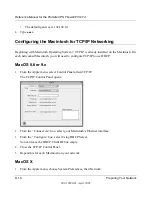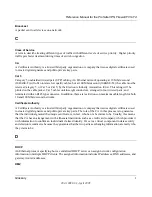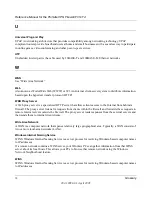
Reference Manual for the ProSafe VPN Firewall FVS114
6
Glossary
202-10098-01, April 2005
gateway then forwards the packet directly to the computer whose address is specified.
Because a message is divided into a number of packets, each packet can, if necessary, be sent by a different
route across the Internet. Packets can arrive in a different order than they were sent. The Internet Protocol
just delivers them. It's up to another protocol, the Transmission Control Protocol (TCP) to put them back in
the right order. IP is a connectionless protocol, which means that there is no continuing connection between
the end points that are communicating. Each packet that travels through the Internet is treated as an
independent unit of data without any relation to any other unit of data. (The reason the packets do get put in
the right order is because of TCP, the connection-oriented protocol that keeps track of the packet sequence in
a message.) In the Open Systems Interconnection (OSI) communication model, IP is in Layer 3, the
Networking Layer. The most widely used version of IP today is IP version 4 (IPv4). However, IP version 6
(IPv6) is also beginning to be supported. IPv6 provides for much longer addresses and therefore for the
possibility of many more Internet users. IPv6 includes the capabilities of IPv4 and any server that can
support IPv6 packets can also support IPv4 packets.
IP
See “Internet Protocol”
IP Address
A four-byte number uniquely defining each host on the Internet, usually written in dotted-decimal notation
with periods separating the bytes (for example, 134.177.244.57). Ranges of addresses are assigned by
Internic, an organization formed for this purpose.
ISP
Internet service provider.
L
LAN
See “Local Area Network”
Local Area Network
A communications network serving users within a limited area, such as one floor of a building. A LAN
typically connects multiple personal computers and shared network devices such as storage and printers.
Although many technologies exist to implement a LAN, Ethernet is the most common for connecting
personal computers and is limited to a distance of 1,500 feet. LANs can be connected together, but if
modems and telephones connect two or more LANs, the larger network constitutes what is called a WAN or
Wide Area Network.
Содержание FVS114NA
Страница 4: ...202 10098 01 April 2005 iv...
Страница 12: ...202 10098 01 April 2005 xii Contents...
Страница 16: ...Reference Manual for the ProSafe VPN Firewall FVS114 1 4 About This Manual 202 10098 01 April 2005...
Страница 116: ...Reference Manual for the ProSafe VPN Firewall FVS114 6 28 Advanced Virtual Private Networking 202 10098 01 April 2005...
Страница 148: ...Reference Manual for the ProSafe VPN Firewall FVS114 9 8 Troubleshooting 202 10098 01 April 2005...
Страница 166: ...Reference Manual for the ProSafe VPN Firewall FVS114 B 16 Network Routing and Firewall Basics 202 10098 01 April 2005...
Страница 200: ...Reference Manual for the ProSafe VPN Firewall FVS114 D 22 Preparing Your Network 202 10098 01 April 2005...
Страница 211: ...Reference Manual for the ProSafe VPN Firewall FVS114 Glossary 11 202 10098 01 April 2005...
Страница 212: ...Reference Manual for the ProSafe VPN Firewall FVS114 12 Glossary 202 10098 01 April 2005...




























